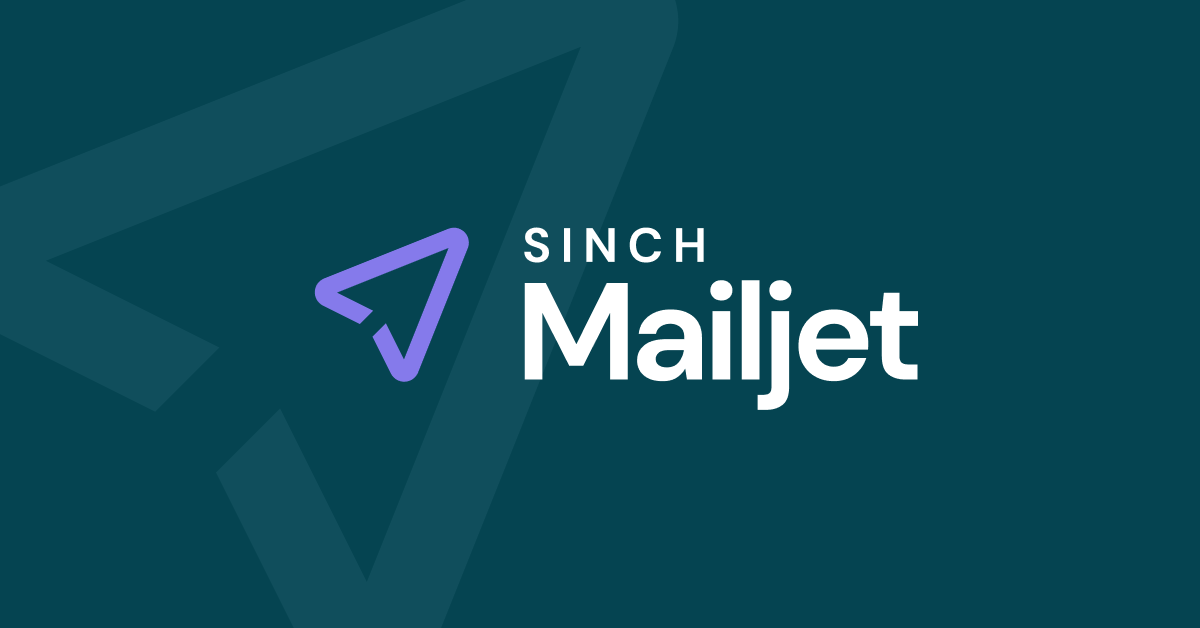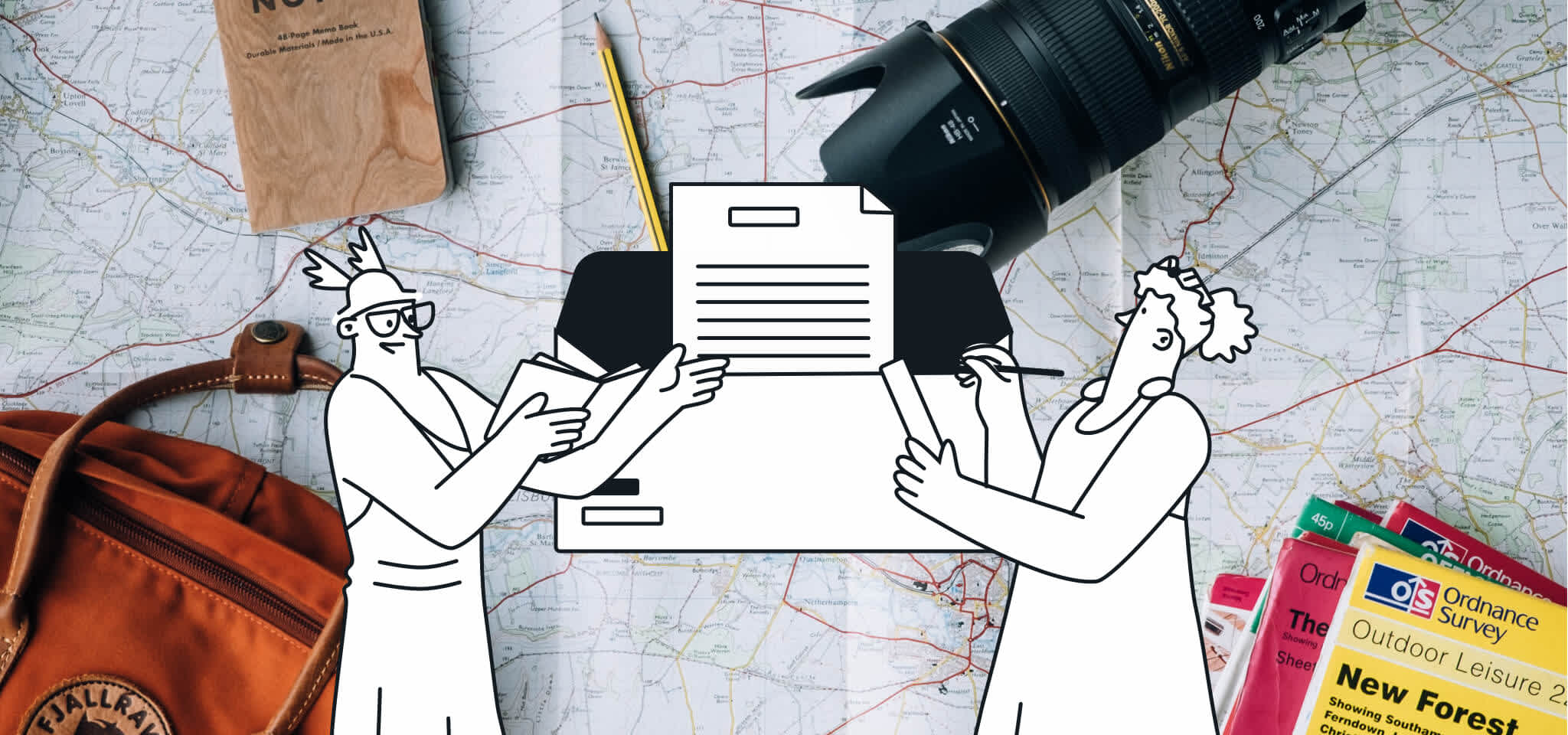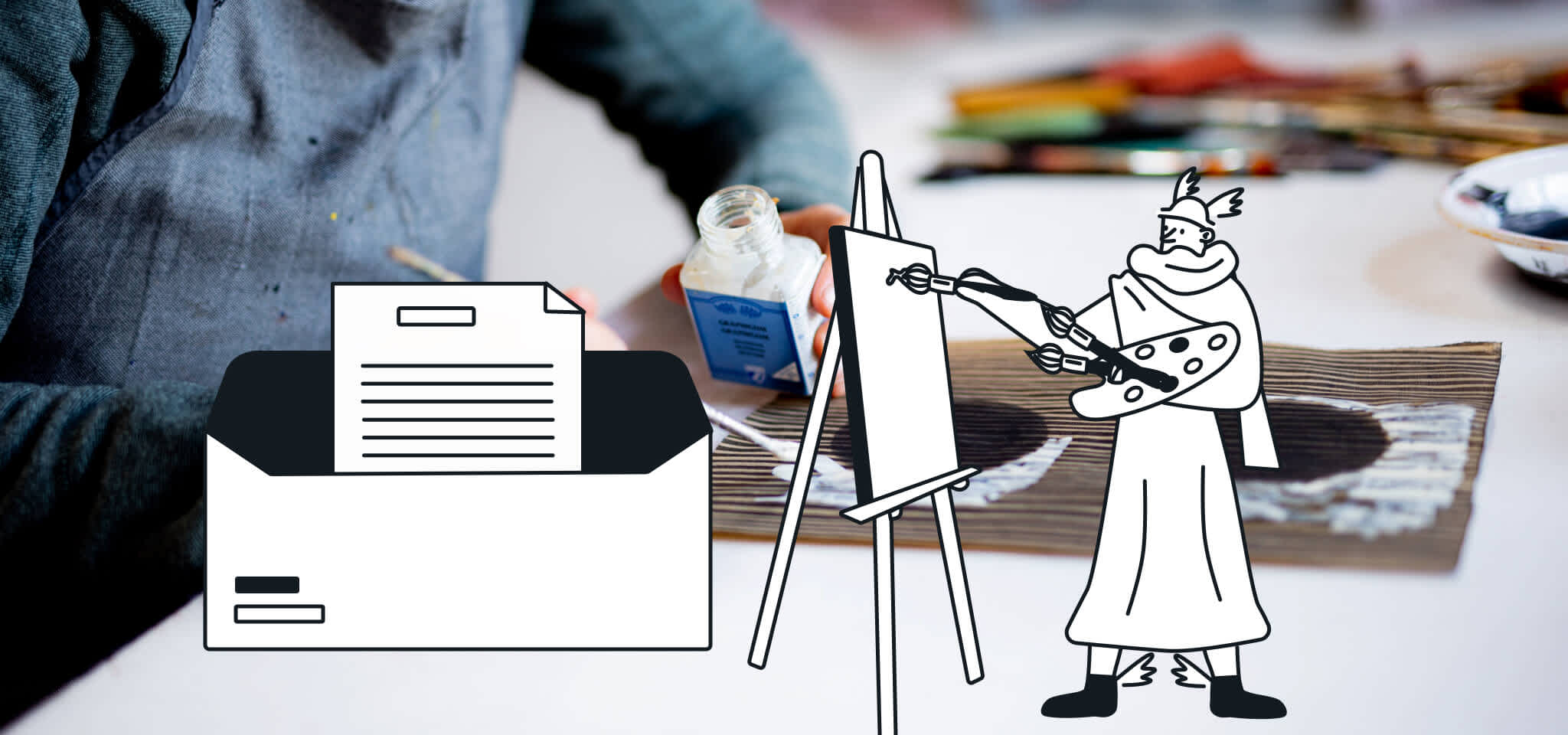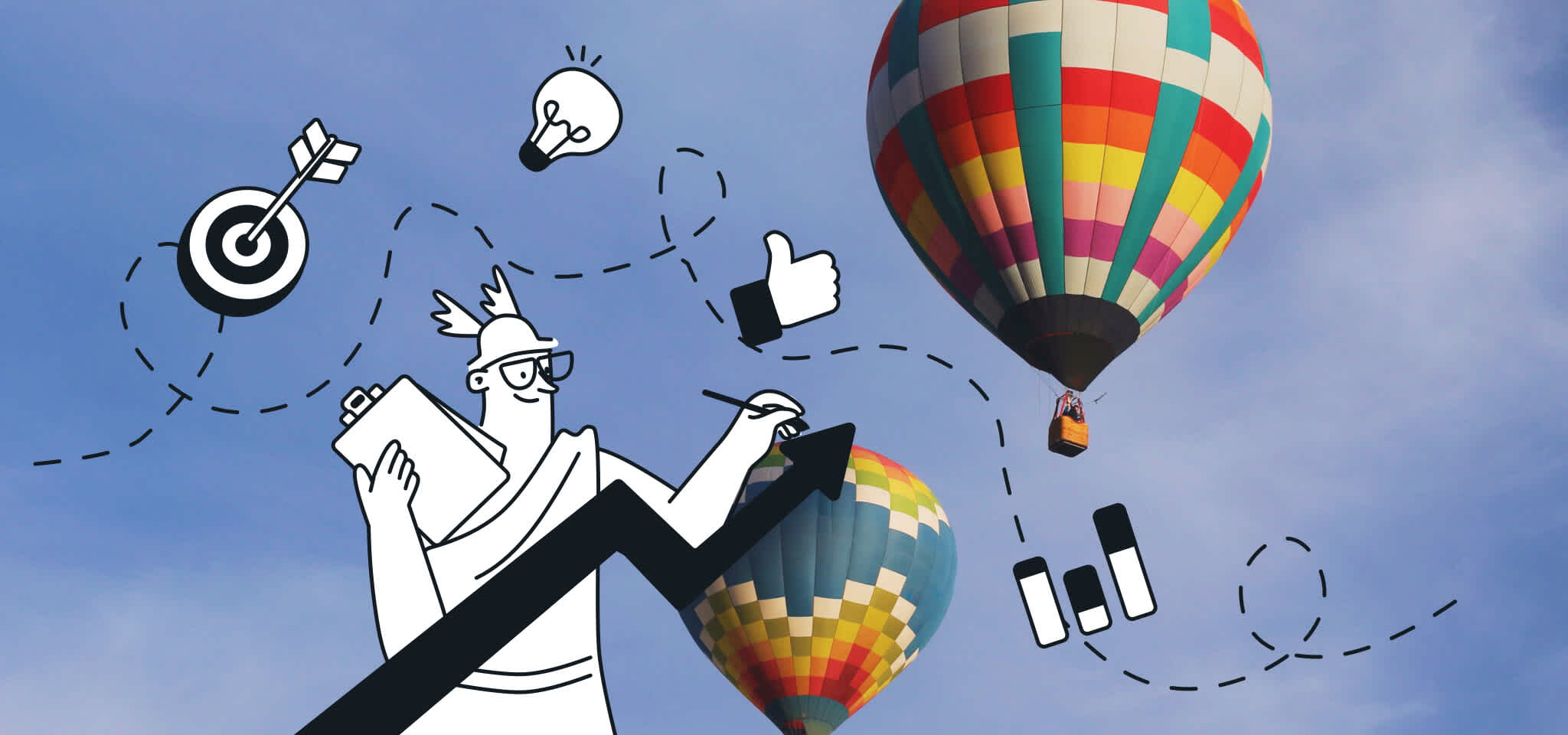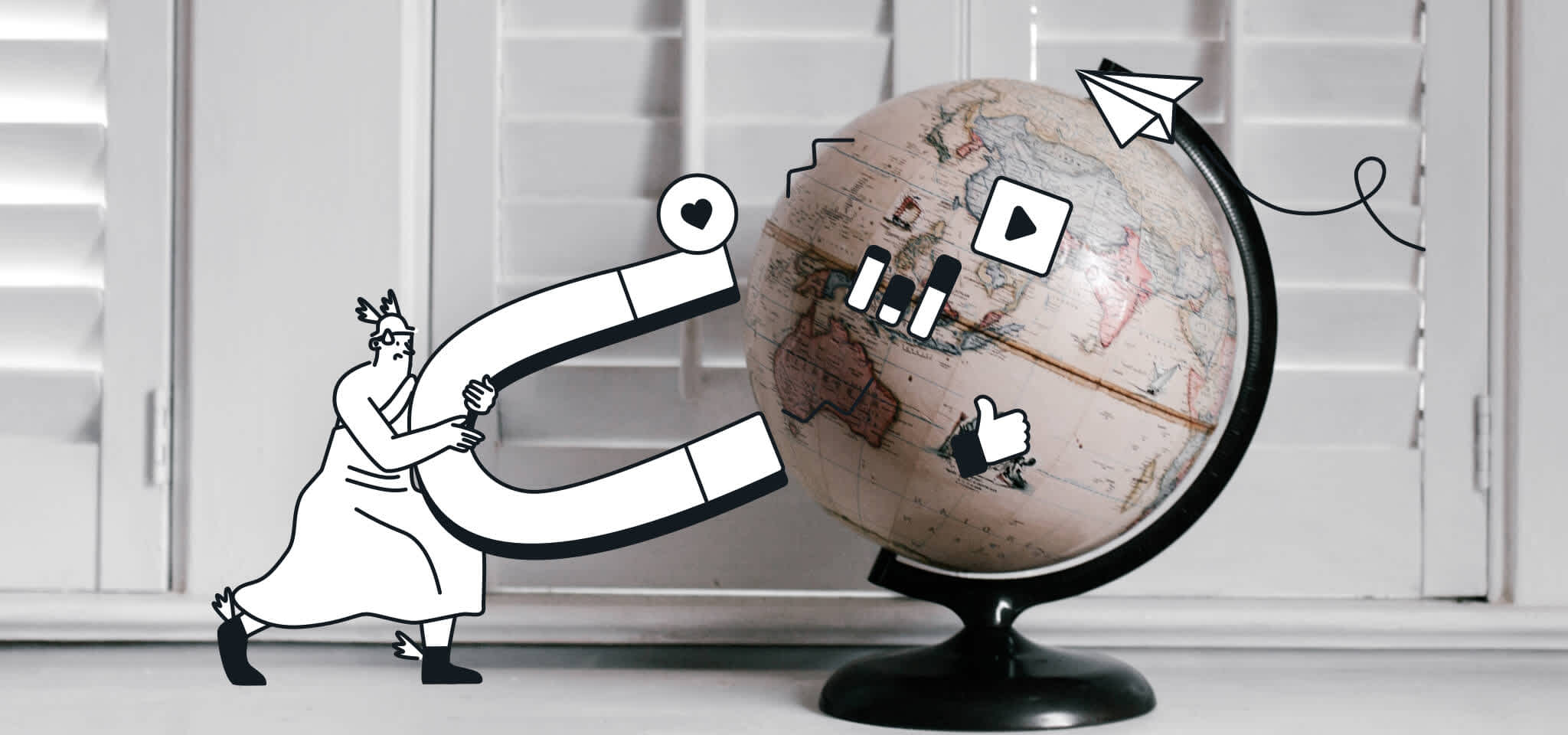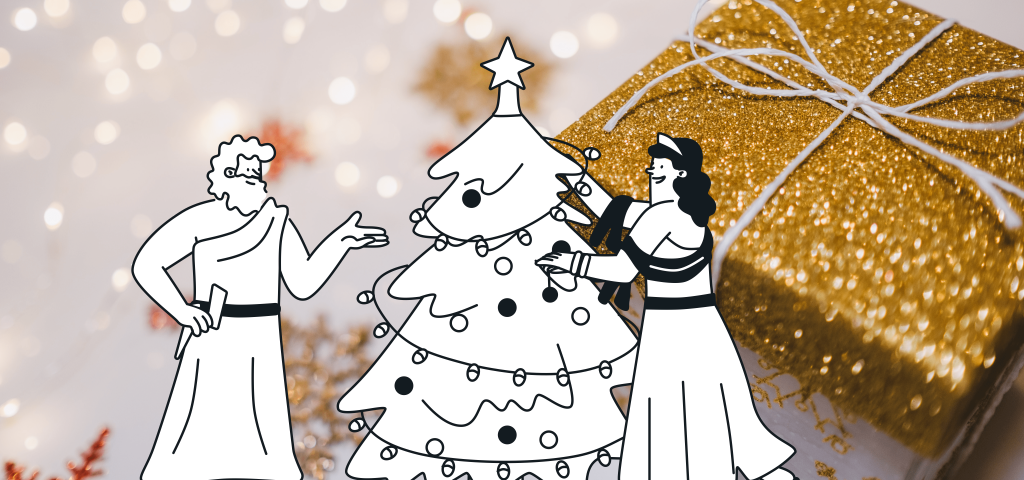Ask anyone about their interests, and most people will probably mention travelling. There are so many people posting about their #wanderlust that it should be easy to beat your sales goals every month, right? And yet, with such a competitive market, it's increasingly hard to turn all those eager travellers into customers. Lucky for you, email marketing is here to help you.
In this guide, we will cover the fundamentals of email marketing for the travel and tourism industry and give you campaign ideas and examples for the most common scenarios.
Chapter 01
Travel and tourism in the digital world
The Internet has forever transformed the way we travel.
Most people spend hours scanning the Web to find the best deals, riffling through tourist guides and leaving a trail of valuable data about their interests, budget and patterns, changing the travel industry in the process. The harder life gets and the more their workload increases, the more inclined people are to get lost in their own imaginary vacations.
Now, the ball is in our court. As marketers, we have the opportunity to grab these people’s attention. It’s not easy, though. Travel and tourism businesses in the digital world face two big challenges:
The customer journey is longer: There are many different aspects and elements users take into account when preparing a trip, so it’s important to map out that customer journey to ensure we have the appropriate touch points throughout the whole lifecycle.
The competition is tougher: The Internet is filled with multitude of travel providers and tempting vacation offers. Targeted customer communication is essential to stand out in such a crowded competitive landscape.
Choosing the right marketing channels to communicate with your customers is key to succeed in the digital world, and email should play a very important role in any omnichannel marketing strategy.
Chapter 02
Creating a strong email strategy for the travel and tourism industry
We know it already, email is the best performing channel for ROI, ahead of SEO. It’s our job to use this endless stream of information to build a superb email marketing strategy that turns tourists all over the world from daydreamers into actual customers.
So, how do we turn a dull inbox into a real gold mine? We’ve got the tips and examples to help your create a winning email strategy for your business.
Define your email goals
It’s never smart to start sending emails out without clear objectives. So before you start building out your first campaign, take some time to think about your overall goals and your more specific ones.
It’s important to be as concrete as possible when establishing your overall goals, which will allow you to design specific milestones you want to reach with each campaign. For example, your overall goal might be to increase your sales by 20%. Your specific goals will help you determine the exact conversion rates you are aiming for in each email.
Build a healthy contact list
Before you begin sending emails, you need to build a list that has the potential to convert. That is, a list of contacts that are interested in what you have to offer.
At Mailjet, we believe that success lies in growing your list organically and not from buying data. The prospect of starting your contact list from scratch might be daunting, but it is key to get the best results.
Asking for consent to send marketing emails ensures users are interested in the content we send, and is also key to comply with data protection regulations, like GDPR. At the end of the day, spending your budget by sending emails to people that are not interested is just a waste of money.

Learn more:
Head to our “How to Build Your Email List Fast - Step-by-Step Guide” to learn more about contact list building.
Read our post “14 Ideas To Increase Your Email List” to find ideas to grow your database.
Conquer responsive email design
The way we browse the Internet and interact with companies online has changed, and so has the technology we use to read our emails. Now, we use a range of devices (tablets, smartphones, wearable…), all of which have different sized screens and display messages in different ways.
When designing templates, it’s essential to keep these different screen sizes in mind. Responsive designs are those that render properly and deliver a consistent message, regardless of your contacts’ device or email client. Your template and your beautiful images, key to take your reader straight to their dream destination, should adapt to the device they’re being viewed on, or they won’t be effective at all.
Learn more:
Read our “Guide to Creating Responsive Emails” to learn about design best practices.
Choose a responsive email editor
While ensuring your design is responsive might seem like a pain, at Mailjet we’ve done the hard work for you. Our drag and drop email editor Passport makes designing emails a breeze. All you need is your creativity and to follow the design best practices we regularly share with you on our blog.

Want these email templates? Create a Mailjet account now and start customizing them now, or try our editor’s demo now to see all you can do with them.
Use customer data to send better emails
Understanding why your customers go to your website, their interests and budgets is essential to produce emails that are not only relevant, but also targeted to each and every one of them. Gaining insight from what they book, when they do it and how much money they spend is priceless information that will allow your email strategy to go from good to great.
Nowadays, there’s a huge amount of data available for email marketers to use, although we don’t always make the most of it. Here are a few ways data can help you build more meaningful emails:
Segment contact data, behavioral data and data based on your users’ previous interactions with your website to better target your customers and to send them contextually relevant emails. There are many examples on how to use segmentation, like targeting contacts in Northern Europe with a campaign about warm destinations, or encouraging big spenders to book a luxury stay at your hotel.
Personalize your messages to engage with your customers on a one-to-one basis. It’s not just about the simple things, like including your contact’s name in the subject line, but also about using tools like dynamic blocks to tailor the content to each and everyone of them.
Use A/B tests to compare the performance of different versions of the same emails. The opportunities are endless - from the basics (from name, subject line, CTA) to aspects such as personalization, content, design, sending frequency or even sending days and times.
Integrate marketing and transactional emails
Before, marketing and transactional emails used to be handled independently. Nowadays, though, companies are expected to offer a seamless customer experience across both marketing and transactional emails. By making sure your marketing and transactional emails have the same look and feel, your customers will know they are communicating with the same company, one with a distinguishable brand identity.
However, using marketing and transactional messages as two complementary email channels is also about leveraging the power of these triggered messages and their possibilities for upselling and cross-selling. Transactional emails in general have high engagement metrics, as they are sent to customers who are awaiting a confirmation. Including promotional opportunities within these emails, like further offers or services, can be a great way to boost your client conversion rates.

Learn more:
Read the post 7 Marketing Ideas With Transactional Emails to find marketing opportunities in your transactional messages.
Understand how deliverability affects your email ROI
Creating and sending beautiful email campaigns is pointless if they’re not landing in the inbox. Even though the hard work seems over when you press the SEND button, your emails go through a whole journey to reach your recipient, and many factors involved could determine whether your email lands in the inbox or the junk folder.
Learn more:
Head to our Email Marketing Deliverability 101 Guide to know more about deliverability and how to get ISPs to see you as a legitimate sender.
Chapter 03
Email campaigns for the customer lifecycle in the travel and tourism industry
We’re sure that after spending quite some time learning about the tools and features that can help boost your email sendings, you’re eager to get new ideas and start creating your own campaigns. We have explored how to combine your transactional and marketing efforts to leverage triggered emails’ open rates, and now it’s time to take a look at some of the marketing emails you can implement.
There are multiple stages in planning for a trip and multiple steps in the customer lifecycle in the tourism industry, and you need to be prepared to walk your customers along the way.
Welcome programs
Welcome series give you the opportunity to greet your customers upon joining your platform and to offer them some valuable information to make the most of your service. Letting your customers know about the kind of communication they can expect from you and allowing them to choose between different options will enable you to send them targeted emails that are more likely to interest them.

Airbnb’s welcome email is great at onboarding users and highlighting the next steps to get started. It's eye-catching and includes clear CTAs to help users navigate the platform.
Birthdays/Anniversaries
Who wouldn’t want to celebrate their birthday somewhere magical? Wish your contacts a ‘Happy Birthday’ and include a discount on a weekend getaway or a promo code they can apply on their next booking.
Loyal customers go a long way. Why not use the data you have available to thank them for X years together? You could include an exclusive offer to reward them for their loyalty.
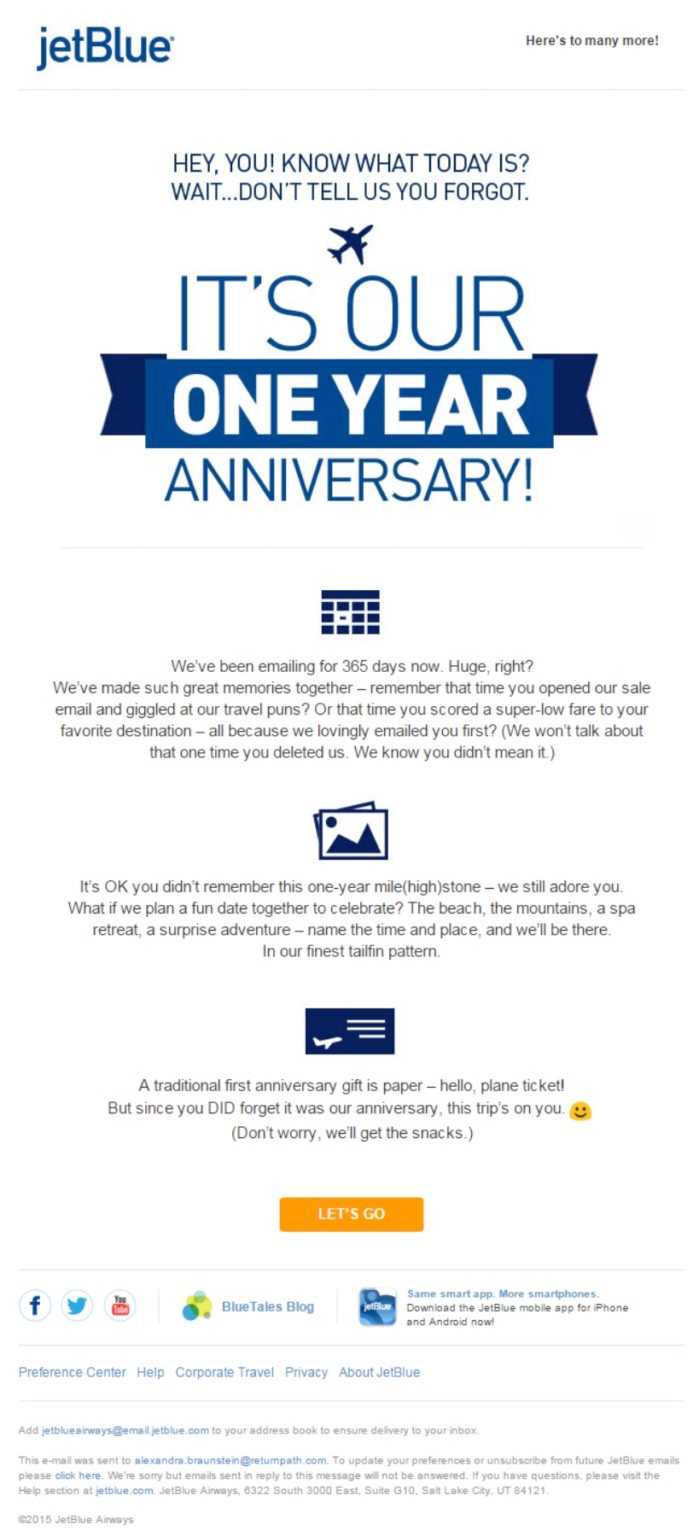
It doesn’t get much better than JetBlue’s anniversary email. This fun, friendly and slightly cheeky approach lets customers know they are valued and encourages them to stay loyal to the brand.
Flash sales
Limited offers are extremely common in the tourism industry. Even though travellers are now getting savvier and exploring different possibilities before booking their trips, many decisions are still made based on great deals and amazing discounts.
Some business have turned the flash sales model into the core of their business, like Secret Escapes, Voyage Privé or Groupon. Even if this is something you are not interested in doing on a regular basis, offering tickets at discounted rates or cheaper upgrades can help boost your sales during a particularly quiet period.

Secret Escapes uses flash sales on a regular basis to entice users to book trips. They always feature a very attractive discount, and put an emphasis on how long you have until the offer ends.
Newsletters
If you ask people about their interests, chances are many of them will say travelling. Even if we don’t have the money, fantasizing about different city-breaks and dream vacations is something we’ve all done at some point. That’s why, creating regular content that promotes your top destinations or exciting leisure offers will allow you to entice your contacts ahead of their upcoming week off.
Going on holiday normally means spending a big amount of money, so people are not likely to book a trip every time they receive your newsletter. But if you regularly send them content that adds value and they love reading, they’ll probably think of you once they’re ready to book their trip.

Skyscanner makes people really want to travel by emailing them travel insights, news, guides and articles. Their clear headings and beautiful pictures really manage to trigger that well known wanderlust fever.
Seasonal events
There are different ways in which seasonal events can be used to increase engagement with your email campaigns. National holidays and vacation periods are always a great excuse to promote and offer exclusive deals on some of your favorite picks. It could be that someone’s not thinking about travelling during the Easter break until they see those amazing pictures in your email.
There are also certain festivities that make places more attractive, like Christmas markets, street festivals, cultural events... Piggybacking on whatever’s taking place in a specific location could be a good way of encouraging people to finally decide on making that trip they’d been thinking about for a while. Even designing creative campaigns around certain marketing moments can have a very positive impact on your conversion.
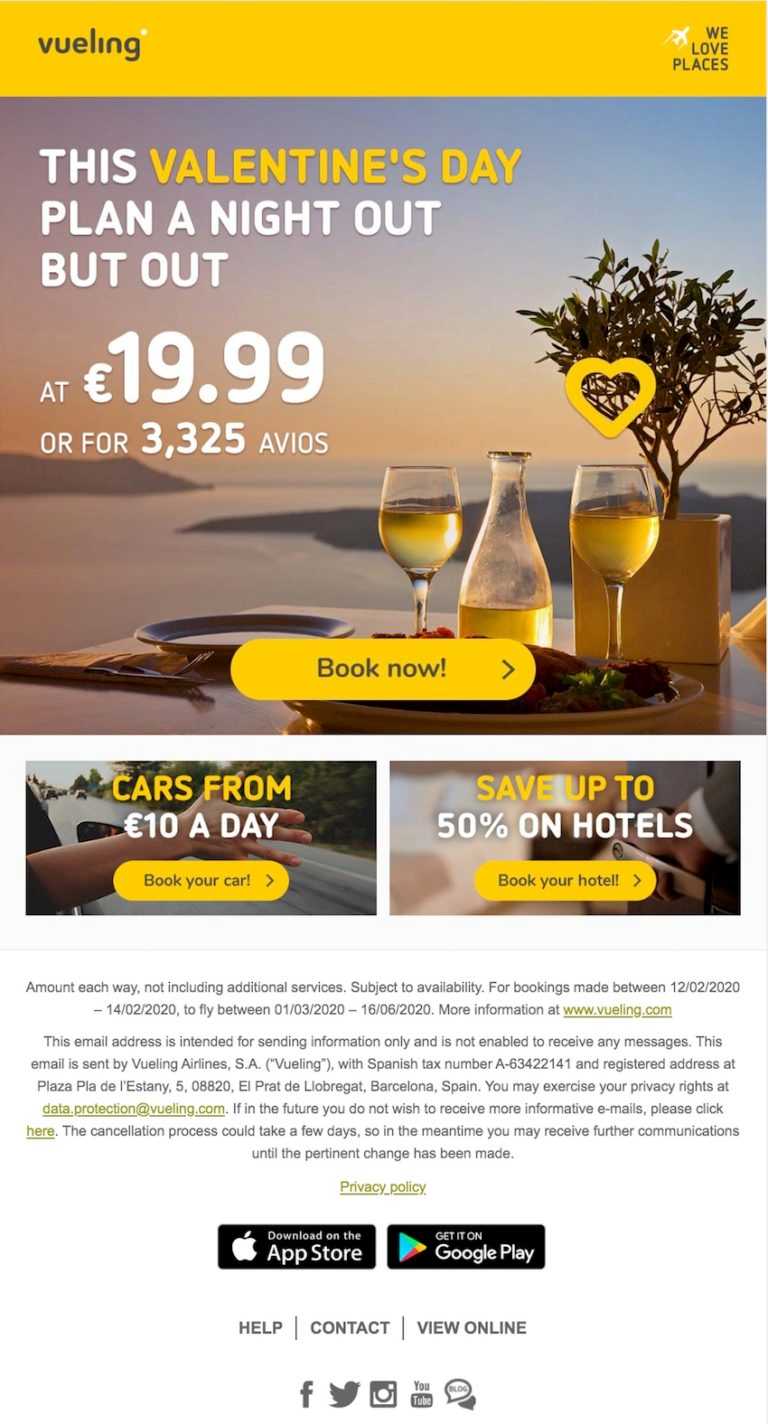
Vueling tempts subscribers with a night out on Valentine's Day with a special email campaign that includes great deals on flights, car rental and hotels. The inspiring visuals, great copy and enticing offer make this a great example of email marketing for special dates.
Information emails
Building a good reputation online is hard work and it takes time, but losing your customers’ trust is something that can happen really easily. If your users have chosen you to book their flights, trains, accommodation or tours, only to find that your website has changed or it’s down, or there’s a strike that will impact their departure times and you haven’t warned them, they’re not going to be happy. People get stressed ahead of their vacations, so anticipating any potential issues and giving customers alternatives goes a long way.

Southern ensures their customers are ready to use their new platform when they decide to book their next trip by carefully explaining their changes. The “text only” email ensures the message is not mistaken for a promotional campaign, and the handwritten signature at the bottom gives it a more personable feel.
Nurturing emails
How many times have you browsed around for flights or accommodation, just to check out the prices? Even if your customers are not ready to book their trip at that time, chances are they won’t forget about it completely. Remind them about their search and tempt them with some nice pictures to ensure they come back to you once they’re ready to complete their booking. You can even add some valuable content, like a city guide or top leisure choices at their destination, to help them make up their minds.
Alternatively, you can send them some similar suggestions based on their previous searches or booking history. If a user has been browsing around for winter sun destinations, why not nurture them with other places they might not have thought about?

Expedia nurtures clients looking for flights to Paris with this fantastic email that includes a powerful combination of images, valuable content and strong CTAs.
Abandoned booking
We’ve all been there. Sometimes you’re just about to complete your booking, but something gets in the way. Maybe it’s the challenges of catering for a large group, maybe you didn’t have your bank card with you or maybe you just thought about it twice and decided it was too much money.
Send customers a reminder email with their booking information and a link to return to their account. You can also tempt them with a special discount, just in case they were having second thoughts.

Norwegian’s simple email reminds users about their abandoned booking and encourages them to take action by letting them know the flight is filling up quickly and ticket prices raising. The CTA allows customers to return directly to the booking stage.
Post-booking/Before travelling
We’ve all received them and, most probably, we’ve all opened them. While, in other industries, purchasing is in fact the end action, booking a trip is by no means the end of your relationship with a customer. Actually, the time span between the booking and the actual trip might last months, so it’s important to keep in contact with reminder emails that provide useful information and additional services the customer might be interested in.
The number of emails you send can vary, but you’ll always want to send one a week or two before their journey, providing them with their booking details again and including upselling and cross-selling offers (upgrades, transfers, tickets to attractions, etc…).

Southwest's reminder email provides users with the necessary information prior to departure, while clearly informing them about the steps they still need to complete. They also use this opportunity to promote alternative products and services.
Price/Availability alerts
We all know how much prices and availability change in the tourism industry. Some of your customers might even spend quite some time searching for the cheapest option and many are in the constant lookout for the perfect time to book in order to get the best deal. Why not send contacts an alert informing them about changes on the price or availability in their desired flight, train or accommodation? Or if something they had browsed before it becomes unavailable, why not suggest them some alternatives?
These fluctuations are likely to give your contacts a sense of urgency to book. However, too many emails might become too spammy and lose all of their effect. The best option is to allow your users to predefine the kind of alerts they want to receive, to ensure the emails you send are actually the emails they want to read.

Skyscannner’s Price Alerts are simple and straight-forward, but still manage to include links to some of their other offers and services. Since Price Alerts are regular and subscribers could find slightly annoying at some point, they make their unsubscribe and email management links very obvious throughout the email.
Thank you email
Once a user has completed their trip, make sure you thank them for their visit. This is a great opportunity to ask for their feedback and encourage them to share their experience online, by directing them to your social media channels. You can also ask customers to share their pictures or user generated content with you - it will be the best kind of promotion.

Volks Hotel’s email uses their Thank You email as an opportunity to ask customers for feedback and reviews. They also reward them with a discount code for future bookings.
Feedback emails
Marketplaces rely on users’ opinions to rate the different activities and accommodations, although not everyone remembers to go back and share an opinion. Even if you are a hotel or travel company and have previously emailed your customer to thank them, they might have completely ignored your feedback link. Make it easy for them by including a quick survey in your email, so they can rate their experience in just a few clicks.

Booking.com knows that travellers around the world read opinions about their hotels before booking. That’s why they make it really easy for customers to rate the place they’ve stayed at.
VIP/Loyalty programs
It is not uncommon for airlines and even hotels to have loyalty or frequent traveller programs to engage customers to return to them. Emailing members to let them know about their points, offering them promotions to increase their balance or rewarding them for reaching a certain milestone is a great way of keeping them engaged and ensuring they remember your company.
Alternatively, you can have different tiers for returning customers that always book their holidays through you, providing them with special discounts as they reach their fifth, tenth, fifteenth booking.
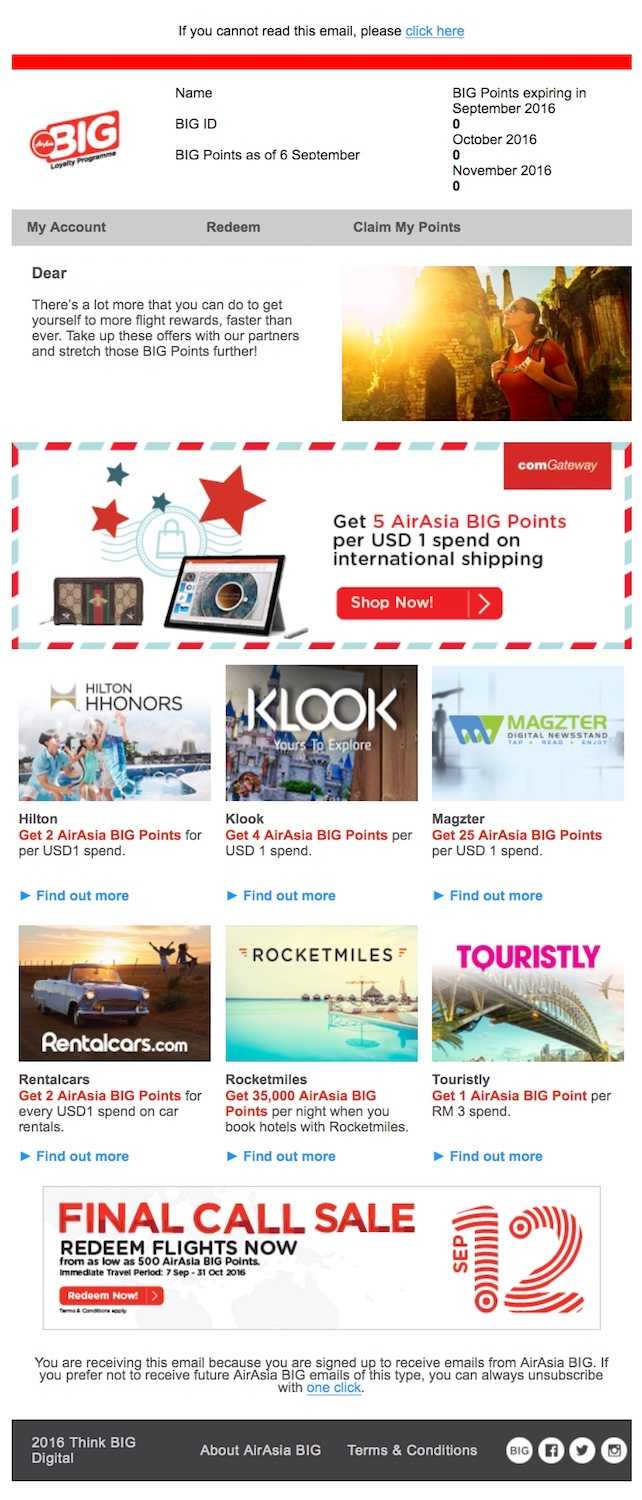
Air Asia encourages frequent travellers to redeem their points and gain extra ones with special deals and offers to make them feel special and increase their loyalty to the company.
Re-engagement programs
For some businesses in the tourism industry, their relationship with their customers might be a one-off. Other companies, though, rely on building a lasting relationship with their users.
If a customer’s been absent from your brand, entice them back with a reactivation campaign. You can remind them about what you offer, tempt them with travel ideas and even add an incentive that could convince them to return to you, instead of booking with one of your competitors. If nothing else works, you can send your inactive contacts a ‘We’ve missed you’ campaign, asking them whether they want to stay engaged or end the relationship. Remember, constantly emailing people that don’t want to receive your messages will impact your deliverability.
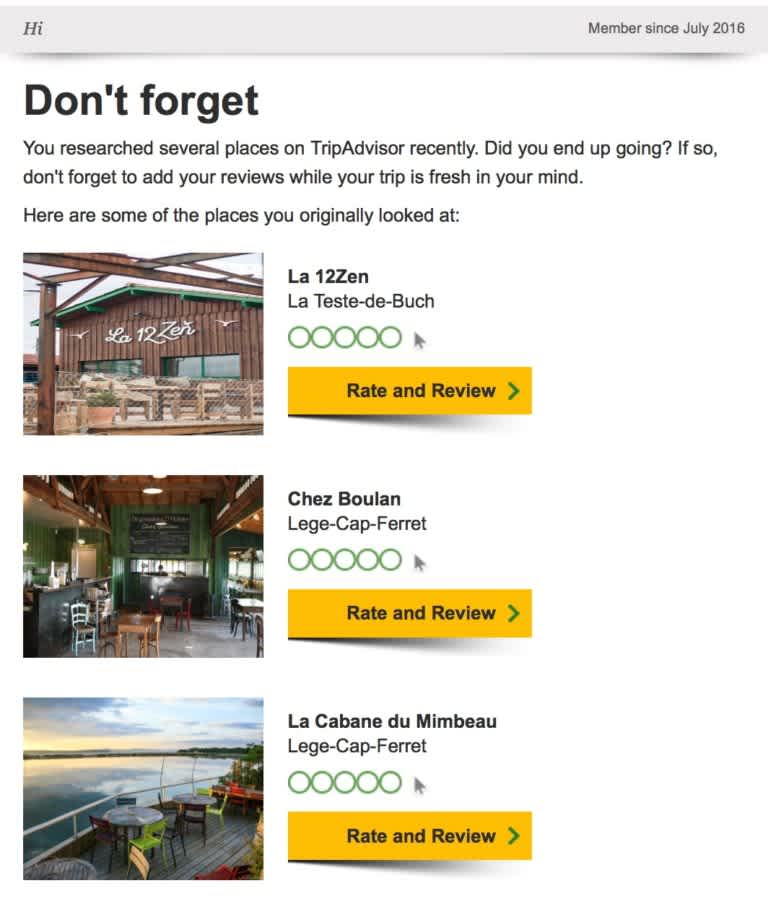
TripAdvisor relies on users providing feedback on the different places they visit. This re-engagement email targets subscribers who had researched specific locations but never returned to share their opinions.
Chapter 04
Summing up
When used wisely, email is a really powerful channel that will not only help you build and maintain a lasting relationship with your customers, but also increase your ROI. Finding the right balance between mass communication and one-to-one personalization is key to make the most out of your email sendings.
However, what works for one business might not work as well for another one, so finding the right email marketing strategy for your company will require testing different options. Get creative, give some of these ideas a go and compare the results to find those that will give your company the biggest uplift.
